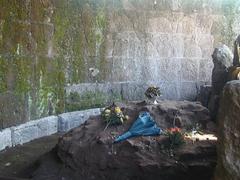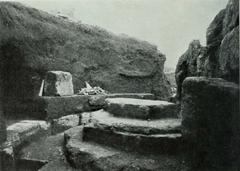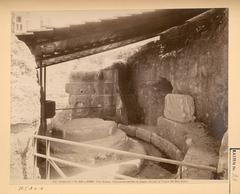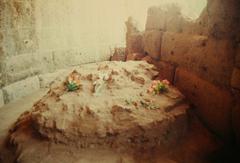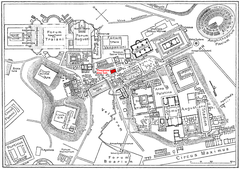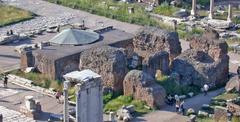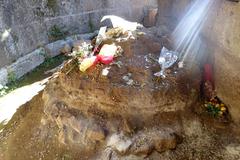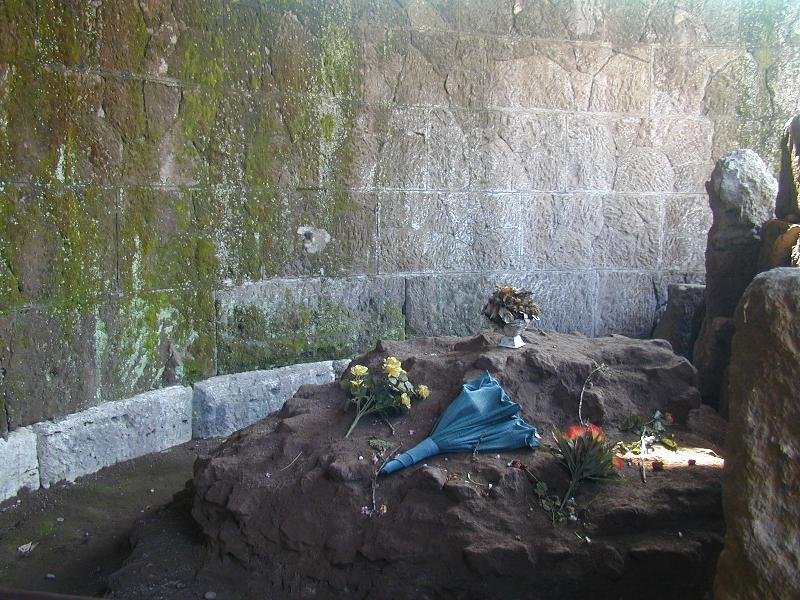
Temple of Caesar, Rome: Visiting Hours, Tickets, and Historical Significance
Date: 14/06/2025
Introduction
The Temple of Caesar (Tempio di Cesare) stands as a monumental testament to Rome’s dramatic transformation from Republic to Empire. Located at the eastern end of the Roman Forum, this site marks the place where Julius Caesar was cremated after his assassination in 44 BCE and subsequently deified by the Senate. Built under Augustus—Caesar’s adopted heir—the temple was both a sacred monument and a central feature of imperial political propaganda, reinforcing Augustus’s claim to divine lineage and cementing Caesar’s enduring legacy in Roman culture.
Today, visitors can explore the temple’s archaeological remains, including its altar and podium, set amidst the iconic ruins of the Forum. This guide provides a comprehensive overview of the temple’s history, architectural features, visitor information, and travel tips to ensure a memorable and insightful visit to one of Rome’s most significant historical sites. For more details, see History Tools, The Geographical Cure, and the official Parco Archeologico del Colosseo website.
Table of Contents
- Historical Context: Julius Caesar’s Deification
- Site Selection and Symbolism
- Construction and Architectural Features
- The Temple’s Role in Imperial Rome
- Archaeological Remains and Modern Discoveries
- Visiting the Temple of Caesar: Hours, Tickets, and Tips
- Accessibility and Nearby Attractions
- Special Events and Guided Tours
- Frequently Asked Questions (FAQs)
- Visual Resources
- Internal Links
- Conclusion
Historical Context: Julius Caesar’s Deification
Julius Caesar (100–44 BCE) was a pivotal figure whose life and death reshaped Roman history. His assassination on the Ides of March, 44 BCE, led to a period of civil war and the ultimate rise of Augustus as the first Roman Emperor. In 42 BCE, the Senate deified Caesar as “Divus Iulius,” establishing a new precedent for imperial deification and linking Augustus’s rule to a divine predecessor. The appearance of a comet during Caesar’s funeral games was interpreted as a sign of his apotheosis and became an enduring symbol on coins and public monuments (History Tools).
Site Selection and Symbolism
The temple was constructed at the precise spot in the Forum where Caesar’s body was cremated. This location, chosen for its centrality and symbolic resonance, was already sacred to the Roman people—a place of public mourning and political drama (History Tools). Augustus’s architectural program intentionally placed the temple among other important monuments, further enshrining Caesar’s memory and emphasizing the divine foundation of the new imperial order (The Geographical Cure).
Construction and Architectural Features
Timeline and Dedication
Construction began soon after Caesar’s deification and the temple was dedicated by Augustus in 29 BCE, following his victory at Actium. The dedication marked not only a new religious cult but also the triumphant beginning of Augustus’s reign (History Tools).
Dimensions and Layout
The temple, though modest compared to others in Rome, measured about 26 by 30 meters and was built atop a high podium. Its orientation, facing the Via Sacra, made it a focal point for forums and ceremonies (The Geographical Cure).
Architectural Style and Artistic Elements
- Podium and Foundation: Constructed from concrete and brick, originally clad in marble. The semicircular exedra in front housed the altar and functioned as a blend of temple and mausoleum (Elsevier Blog).
- Columns and Façade: The hexastyle (six-column) Corinthian façade used white marble columns about 11 meters high, with a deep pronaos leading to the cella.
- Interior: The cella featured the cult statue of Caesar, decorated with marble and friezes depicting his apotheosis and military triumphs.
- Altar: The altar, marking the precise site of Caesar’s cremation, remains a focal point for modern visitors.
- Decorative Elements: Reliefs, friezes, and colored marbles, along with traces of ancient paint and gilding, created a vivid effect in the Mediterranean light (My Rome Pass).
- Symbolism: The statue of Caesar bore a star on his head, referencing the comet and his divine status (Elsevier Blog).
Associated Structures
Two triumphal arches flanked the temple, commemorating Augustus’s victories at Actium and Carrhae, underscoring the temple’s imperial associations (The Geographical Cure).
The Temple’s Role in Imperial Rome
The Temple of Caesar served as a center for the imperial cult, setting a precedent for the deification of future emperors. Augustus and his successors used the site for ceremonies, reinforcing their own legitimacy by associating themselves with Caesar’s divinity (History Tools). The temple’s public platform was used for speeches and official events, intertwining religious veneration with statecraft.
Archaeological Remains and Modern Discoveries
Much of the temple’s superstructure was stripped during the Middle Ages, but the podium, altar, and parts of the foundation remain. The altar continues to receive flowers and coins from modern visitors, reflecting the site’s enduring significance (Travel Curious). Recent research, including pollen analysis from the cremation pyre, has confirmed ancient accounts of Caesar’s funeral rites (History Tools).
Visiting the Temple of Caesar: Hours, Tickets, and Tips
Visiting Hours
The Temple of Caesar is accessible during the Roman Forum’s opening hours:
- March–August: 8:30 am – 7:15 pm
- September: 8:30 am – 7:00 pm
- October: 8:30 am – 6:30 pm
- November–February: 8:30 am – 4:30 pm
Last entry is typically one hour before closing. Closed on January 1 and December 25. Always confirm hours before your visit at the official website.
Tickets
Entry to the Temple of Caesar is included with the Roman Forum/Colosseum/Palatine Hill ticket:
- Standard Adult: €15–€18 (Viaggionei Fori)
- Reduced Ticket: €10 for eligible visitors (students, teachers, groups)
- Free Entry: Children under 6, visitors with disabilities (plus one carer), EU-licensed guides
- Integrated Ticket: €18 (includes Domus Romane and multimedia show, booking required)
Advance online purchase is highly recommended, especially during peak season (Tiqets).
How to Get There
The main entrance to the Forum is on Via della Salara Vecchia. The Colosseo (Line B) metro station and several bus lines (51, 75, 85, 87, 118) serve the area.
Accessibility and Nearby Attractions
- Accessibility: Wheelchair-accessible routes are available to the main areas of the Forum, including the Temple of Caesar. Free entry for visitors with disabilities and their companions (Viaggionei Fori).
- Facilities: Restrooms and water fountains are found within the Forum complex.
- Nearby Attractions: The Colosseum, Palatine Hill, Arch of Titus, Basilica Julia, Temple of Saturn, and Capitoline Museums are all within walking distance. The Pantheon, Trevi Fountain, and Temple of Hadrian are also nearby.
Special Events and Guided Tours
Guided tours in multiple languages are available, providing historical context and deeper insight into the temple and the Roman Forum. The “Journey through the Forum of Caesar” multimedia show offers immersive storytelling with narration, music, and visual effects, available in several languages (Viaggionei Fori).
- Show Duration: 50 minutes; Domus visit: 1 hour
- Show Times: Evenings, May–September
- Entry Point: Near Trajan’s Column
Frequently Asked Questions (FAQs)
Q: What are the Temple of Caesar’s opening hours?
A: The site is open daily from 8:30 am, with seasonal closing times. Last entry is one hour before closing (Viaggionei Fori).
Q: How do I buy tickets?
A: Tickets are available online (Viaggionei Fori), at the Forum entrance, or via platforms like Tiqets.
Q: Is the Temple of Caesar accessible?
A: Yes, accessible routes are provided for visitors with reduced mobility.
Q: Are guided tours and audio guides available?
A: Yes, both are available in multiple languages.
Q: What should I bring?
A: Comfortable shoes, water, sun protection, and a camera.
Visual Resources
Include high-quality images of the Temple of Caesar’s podium, altar, and surrounding Forum with descriptive alt text such as “Temple of Caesar podium in the Roman Forum, Rome.” Virtual tours and site maps can further enhance your visit.
Internal Links
Conclusion
The Temple of Caesar remains a profound symbol of Rome’s transition from Republic to Empire. Its surviving ruins—the altar, podium, and the site of Caesar’s cremation—evoke the temple’s religious, political, and cultural significance within the Roman Forum. By planning ahead with up-to-date information on visiting hours, ticketing, and nearby attractions, visitors can fully immerse themselves in the rich tapestry of ancient Rome. For a deeper experience, consider guided tours, multimedia shows, and the Audiala app for expert audio guides. Stay informed via official channels for the latest updates and events.
References and Further Reading
- The Temple of Caesar: Honoring a Slain Dictator’s Legacy (History Tools)
- The Temple of Caesar in the Roman Forum (The Geographical Cure)
- Temple of Caesar Visiting Hours, Tickets, and Nearby Attractions (Viaggionei Fori)
- Roman Forum (World History Encyclopedia)
- Visiting the Temple of Caesar: History, Significance, and Practical Guide (Sightseeing Tours Italy)
- Visiting the Roman Forum (Rome.info)
- Parco Archeologico del Colosseo Official Site
